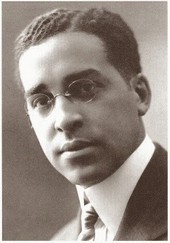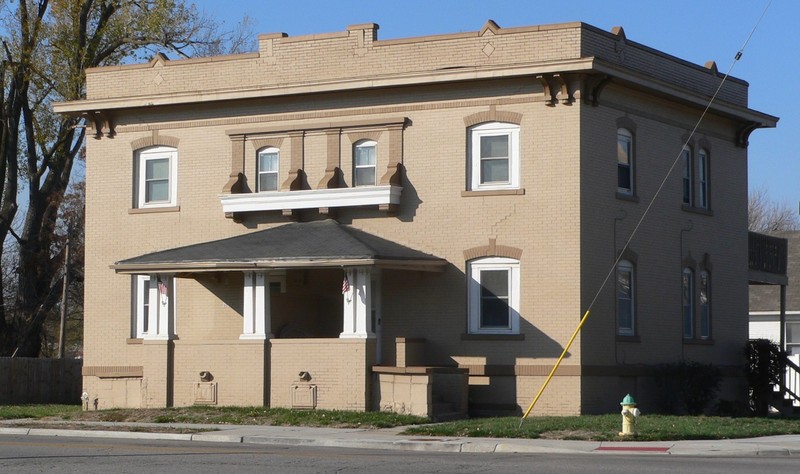Broomfield Rowhouse
Introduction
Text-to-speech Audio
The Broomfield Rowhouse is located in North Omaha, a community that has been the center of Omaha's African-American community since the early 20th century. The historic rowhouse was constructed in the aftermath of the devastating 1913 Easter Sunday Tornado that tore through North Omaha. Clarence W. Wigington, a lauded African American architect from Omaha, designed the rowhouse, and the building won first prize from Good Housekeeping magazine for the best two-family dwelling. The name comes from the building's first owner, Jack Broomfield, an African American who played a significant role within the Democratic political machine controlled by "Boss" Tom Dennison.
Images
Clarence "Cap" Wigington, photographed circa 1905

Broomfield Rowhouse

Backstory and Context
Text-to-speech Audio
Jack H. Broomfield, an African American, came to Omaha in 1887 after losing his leg in a train wreck, working as a Pullman porter. He worked in various jobs before opening a saloon and eventually becoming an integral part of the Omaha "political machine." Tom Dennison, although never working as an elected official, served as Omaha's political machine "boss" from 1900 to 1933. Dennison, a professional gambler, controlled Omaha politics, backing Omaha Mayor "Cowboy" Jim Dahlman (and Dennison supporter) for nearly twenty-five years. Dennison provided gifts, bribes, jobs, and numerous other items in order to garner votes. In particular, he handpicked precinct lieutenants who delivered the votes of their community during elections. Broomfield was one of those lieutenants; he secured the votes of the Black community for Dahlman.
In 1913, on Easter Sunday (March 23), a devastating tornado tore through Omaha (notably the African American neighborhoods of North Omaha). The tornado damaged more than 1,800 homes, killed 140 people, and injured another 350. Near the site of the greatest devastation from the storm, 25th and Lake, the Broomfield Rowhouse was built later that same year, owned first by Broomfield and designed by lauded African American architect Clarence Wesley Wigington.
Wigington was born on April 21, 1883, in Lawrence, Kansas, but moved to Omaha at five months old. Although Wigington did not begin school until the age of ten, he condensed eight years of classwork into five, and he attended an evening art school from 1900 to 1904. Two of his elementary school teachers believed in him and paid half of his art school tuition. He had won three first-place certificates at the 1899 Trans-Mississippi and International Exposition in Omaha at the age of fifteen. Three years later, Wigington took a job as a draftsman for Omaha's nationally renowned architect, Thomas R. Kimball. He worked for Kimball for six years before opening his own office. Wigington was one of only fifty-nine black architects, artists, and draftsmen listed in the 1910 federal census. Wigington's most prolific work in Omaha occurred between 1912 and 1914, during which period he designed nine houses for some of the leaders of the African-American community. Among these commissions, he designed a bungalow for Dr. Leonard E. Britt, one of the organizers of the Omaha chapter of the National Association for the Advancement of Colored People (NAACP). It was also during this 1912-1914 period that Wingingon's Broomfield Rowhouses arose.
A rowhouse differs from a duplex or a double house in that it is more commercial in appearance, having a flat roof and a simple design that allows for additional rowhouses to be added to the building at a later date. Construction of Broomfield Rowhouses finished in 1913, but Wigington created the designs four years earlier as part of a competition for Good Housekeeping magazine. The magazine awarded the design first prize for the best two-family dwelling.
In 1914, Wigington and his family moved to St. Paul, Minnesota. However, despite scoring the highest grade among seven candidates on a civil service exam, he did not get hired to work in the City Architect's Office. Instead, he took a job as a temporary draftsman, a position that became permanent in 1915. Finally, by the winter of 1915, Wigington's patience paid off as he became the country's first African American municipal architect. As a staff member for the City Architect's Office in St. Paul, Wigington designed numerous public buildings; three are listed among the National Register of Historic Places. Moreover, during the Great Depression (aided by New Deal funds), he drew acclaim for designing ice palaces and ice fortresses for various parks around St. Paul. In 1942, the city promoted him to "architectural designer," a position created specifically for Wigington, but a lack of funding during World War II prevented him from ever designing a major public building again.
Sources
"Clarence ‘Cap’ Wigington, Architect born." African American Registry (AAREG). Accessed February 19, 2023. https://aaregistry.org/story/cap-wigington-was-a-midwestern-architect/.
"Dennison’s Political Machine." Nebraska Public Media Foundation. nebraskastudies.org. 2023. https://nebraskastudies.org/en/1900-1924/racial-tensions/dennisons-political-machine/.
Dolberg, Jil and Grant Landreth. "Registration Form: Broomfield Rowhouse." National Register of Historic Places. nps.gov. 2007. https://npgallery.nps.gov/GetAsset/32e58ab6-64cc-4977-a017-d03066819fef.
Larsen, Lawrence H., Barbara J. Cottrell, Harl A. Dalstrom, and Kay Calame Dalstrom. Upstream Metropolis: An Urban Biography of Omaha and Council Bluffs. Lincoln, NE: University of Nebraska Press, 2007.
By Unknown author - https://northomahahistory.com/2014/10/30/a-biography-of-cap-clarence-wigington-an-architect-in-north-omaha-nebraska/ (via Cap Wigington-An Architectural Legacy in Ice and Stone explores Wigington’s architectural legacy, David Vassar Taylor), Public Domain, https://commons.wikimedia.org/w/index.php?curid=69493081
By Ammodramus - Own work, CC0, https://commons.wikimedia.org/w/index.php?curid=22456825
